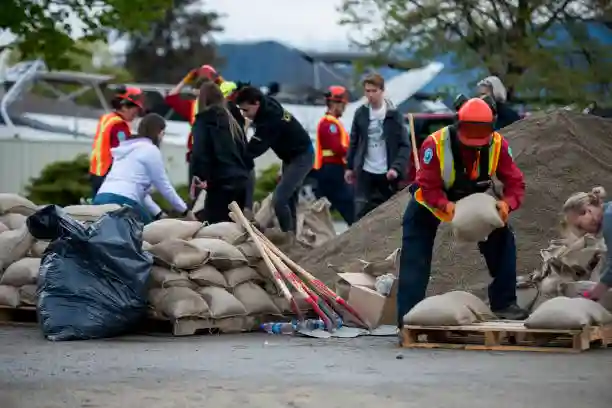Disasters hit without warning. People need help fast. Relief teams save lives when storms, floods, and earthquakes destroy homes. This guide shows how to organize help when bad things happen.
What Is Disaster Relief?

Disaster relief means helping people right after bad events happen. Teams bring food, water, and safe places to stay. They help fix broken things. They make sure people are okay.
Relief work happens for many problems:
- Big storms like hurricanes
- Floods that cover whole towns
- Earthquakes that knock down buildings
- Fires that burn forests and homes
- Sickness that spreads fast
- Bad accidents at factories
- Problems with computers and power
Each problem needs different kinds of help. Teams must be ready for all types.
How Relief Work Gets Done
Relief work has five main steps. Each step has its own job to do.
Step 1: Stop Bad Things Before They Happen
The first step tries to stop disasters before they start. Teams work to:
- Find places where bad things might happen
- Check which areas get hurt most
- Make rules for safe building
- Set up warning systems
- Teach people about dangers
This step saves the most lives. It costs less money too.
Step 2: Make Things Stronger
Some bad things will happen anyway. The second step makes them less harmful:
- Build stronger roads and bridges
- Put up walls to stop floods
- Make safe paths for people to leave
- Fix old buildings to be safer
- Make deals with nearby towns for help
Strong buildings save lives when disasters hit.
Step 3: Get Ready
The third step gets everyone ready before disasters happen:
- Train people who will help
- Store food, water, and supplies
- Practice what to do in emergencies
- Set up ways to talk to each other
- Plan where people will go to be safe
Good planning makes everything work better when disasters happen.
Step 4: Help Right Away
The fourth step happens when disasters hit. Teams do these things:
- Open emergency command centers
- Move people away from danger
- Open safe places for people to stay
- Give medical care to hurt people
- Fight fires and rescue trapped people
- Fix broken power lines and water pipes
Quick action saves the most lives.
Step 5: Fix Everything
The last step helps towns get back to normal:
- Turn the lights and water back on
- Build new homes and businesses
- Help people feel better after scary times
- Count up what got broken
- Learn how to do better next time
Recovery can take months or years. It needs patience and hard work.
Building Good Relief Teams
Good relief teams need clear plans. Everyone must know their job. Teams work best when they have good leaders.
What Every Team Needs
Relief teams must have these things:
- Clear bosses – someone in charge who makes decisions
- Good talking systems – ways for teams to share information
- Supply managers – people who track food, water, and tools
- Volunteer helpers – extra people who want to help
- Money managers – people who handle donations
- Partner groups – other teams they work with
How Teams Are Set Up
Teams use a system called ICS. It puts people in the right jobs:
- Main Boss – runs the whole operation
- Action Teams – do the actual rescue and help work
- Planning Teams – figure out what needs to happen
- Supply Teams – get tools, food, and equipment
- Money Teams – pay for things and track costs
This system works for small problems and big disasters.
Training Relief Workers
People need training to help safely. Important classes include:
- First aid and CPR
- How to work in emergencies
- Staying safe around dangerous things
- Finding and rescuing people
- Helping people who are scared or sad
- Working with people from different backgrounds
Training helps people do their best work.
Working with Other Groups
Big disasters need lots of different groups working together. Good teamwork helps more people.
Who Helps in Disasters
Many types of groups help when disasters happen:
- Government teams – FEMA, National Guard, health departments
- Local helpers – police, fire fighters, hospitals
- Charity groups – Red Cross, Salvation Army, church groups
- Private companies – power companies, phone companies, stores
- Volunteer teams – citizens who want to help
The National Plan
America has a plan for how groups work together. It has 15 different job areas:
- Moving people and supplies
- Talking between teams
- Fixing roads and buildings
- Fighting fires
- Making plans and sharing information
- Finding places for people to stay
- Getting supplies where they need to go
- Taking care of sick and hurt people
- Finding and rescuing people
- Cleaning up dangerous spills
- Taking care of farms and animals
- Fixing power systems
- Keeping people safe
- Helping businesses work again
- Talking to news reporters and the public
Each job has teams that know how to do it well.
Managing Supplies and Equipment
Relief teams need lots of supplies. Managing them well helps more people faster.
Important Supplies
Teams must have these basic things ready:
- Food and water – meals that last long, clean water, baby formula
- Shelter items – tents, warm blankets, beds
- Medical supplies – first aid kits, medicines, hospital equipment
- Cleaning supplies – portable toilets, soap, toothbrushes
- Communication tools – radios, phones, charging stations
- Work tools – generators, chainsaws, pumps, trucks
Keeping track of supplies prevents running out at bad times.
Getting Supplies Where They Need to Go
Disasters can break roads and stop normal deliveries. Smart planning includes:
- Storing supplies in several safe places
- Having backup suppliers ready
- Finding different ways to deliver things
- Sharing supplies with other groups
- Using computers to track everything
Managing Volunteers
Volunteers give relief teams extra hands to help. But they need good management:
- Finding volunteers – using websites, community groups, and friends
- Checking backgrounds – making sure volunteers are safe to work with
- Teaching skills – showing volunteers how to help safely
- Giving jobs – putting people where they can help most
- Taking care of volunteers – providing food, places to sleep, and thanks
- Keeping volunteers safe – giving them proper equipment and training
Good volunteers make relief work much more effective.
Talking During Disasters
Clear communication keeps everyone working together. It also helps scared people know what to do.
Emergency Communication Tools
Relief teams need communication that works even when normal systems break:
- Two-way radios – for teams working nearby
- Satellite phones – when cell towers stop working
- Ham radio – backup system run by trained volunteers
- Social media – for reaching lots of people fast
- Emergency broadcasts – for warnings and safety instructions
Keeping the Public Informed
People need good information to stay safe and make smart choices:
- Regular updates about what is happening
- Clear instructions for staying safe
- Information about where to get help
- Correction of wrong rumors
- Working with news reporters for accurate stories
Good information prevents panic and saves lives.
Sharing Information Between Teams
Different groups need to share information to work well together:
- Using the same radio channels and codes
- Safe ways to share private information
- Regular meetings to update everyone
- Shared offices for coordinated messages
- Computer systems for sharing real-time updates
Managing Money for Relief Work
Disaster relief costs lots of money. Good money management makes sure funds help the most people.
Where Money Comes From
Relief groups get money from different places:
- Government grants – emergency funds from cities, states, and federal government
- Private donations – money from individuals who want to help
- Company support – businesses that sponsor relief efforts
- Foundation grants – charitable organizations with disaster programs
- Fundraising events – community events that raise money
- Insurance money – coverage for damaged buildings and equipment
Having many money sources helps groups keep working.
Spending Money During Emergencies
Emergency spending requires flexible money management:
- Fast buying – getting critical supplies quickly
- Tracking costs – writing down all expenses for later repayment
- Preventing theft – making sure money is used properly
- Following rules – using donations the way donors wanted
- Making reports – showing funders how money was spent
Getting Money Back
Many disaster costs can be repaid through government programs:
- FEMA assistance – federal repayment for emergency work
- State programs – additional help from state governments
- Insurance claims – coverage for property damage
- Mutual aid – cost-sharing with other communities
Keeping good records helps get money back later.
Using Technology in Relief Work
Modern technology helps relief teams work faster and save more lives.
Mapping Systems
Computer mapping helps teams see where problems are:
- Showing damaged areas on maps
- Finding vulnerable people and resources
- Planning safe routes for evacuation
- Tracking where supplies are deployed
- Supporting damage assessment after disasters
Maps make it easier to coordinate help efforts.
Phone Apps and Social Media
Smartphones and social media create new ways to help:
- Crowdsourcing – citizens report damage through apps
- Social media watching – seeing what people need through posts
- Volunteer apps – signing up and organizing helpers
- Donation platforms – online systems for giving money and supplies
- Emergency alerts – sending warnings directly to phones
Technology connects helpers with people who need assistance.
Information Systems
Good record keeping helps teams track their work:
- Client databases for tracking who gets help
- Supply systems for managing inventory
- Financial systems for tracking expenses
- Personnel systems for managing workers
- Performance tracking for measuring success
Helping Vulnerable People
Some people need extra help during disasters. Planning ahead makes sure no one gets forgotten.
Who Needs Extra Help
Certain groups face more danger during disasters:
- Older people – may need help moving or getting medicine
- People with disabilities – need accessible transportation and shelters
- Children and families – need special care and family connections
- Poor families – lack money for evacuation and recovery
- Non-English speakers – need information in their own languages
- Homeless people – already lack safe housing
Planning for Special Needs
Relief teams must plan specifically for vulnerable people:
- Reaching out in multiple languages and formats
- Making sure shelters work for people with disabilities
- Providing transportation for people who cannot drive
- Keeping lists of people who may need special help
- Working with community groups that serve vulnerable populations
- Training workers in cultural understanding
Legal Requirements
Relief groups must follow laws protecting vulnerable people:
- Disability access laws for buildings and services
- Fair housing laws for temporary housing
- Child protection rules for unaccompanied children
- Privacy protection for personal information
- Anti-discrimination policies for service delivery
Long-Term Recovery Work
Quick response saves lives, but long-term recovery rebuilds communities.
Planning for Recovery
Good recovery needs complete planning:
- Damage checks – seeing everything that got broken
- Needs assessment – figuring out what resources are needed
- Setting priorities – deciding what to fix first
- Finding resources – getting money and materials for rebuilding
- Making action plans – creating detailed steps for recovery
- Tracking progress – watching recovery activities and results
Building Back Better
Recovery creates chances to reduce future disaster risks:
- Making stronger building rules and standards
- Improving roads, bridges, and utilities
- Moving development away from dangerous areas
- Improving warning and evacuation systems
- Building community skills for future disasters
Economic Recovery
Disasters can destroy local jobs and businesses:
- Helping small businesses reopen
- Bringing back tourism and other key industries
- Rebuilding public buildings and services
- Creating temporary jobs for recovery work
- Attracting new businesses and investment
Economic recovery helps communities become strong again.
Measuring Success
Good relief groups track their performance to improve and show results.
Important Measurements
Key numbers for disaster relief include:
- Speed – how fast help arrives after disaster hits
- Coverage – percentage of affected people getting help
- Efficiency – cost per person helped
- Effectiveness – meeting stated goals
- Satisfaction – feedback from disaster survivors
- Safety – injury rates among workers and volunteers
Learning from Experience
After big operations, groups should review their work:
- Writing down what worked well and what could improve
- Getting feedback from workers, volunteers, and community partners
- Looking at performance data and financial information
- Identifying lessons learned and best practices
- Updating plans based on findings
- Sharing insights with other groups
Getting Better All the Time
The best relief groups always work to improve:
- Regular training and practice exercises
- Investment in new technology and equipment
- Staff development and leadership planning
- Building partnerships with other organizations
- Community engagement and feedback collection
- Research into new approaches and methods
Building Strong Communities
The real goal of disaster relief is building communities that can handle future disasters.
What Makes Communities Strong
Strong communities share these features:
- Prepared people – residents know what to do when disasters happen
- Strong relationships – neighbors help each other
- Diverse economy – multiple types of jobs and businesses
- Good infrastructure – roads, power, and water systems that work
- Good leadership – effective government and community groups
- Ability to adapt – learning and changing based on experience
Getting Communities Involved
Building strength requires everyone to participate:
- Public education about disaster risks and preparation
- Neighborhood emergency response team training
- Community practice drills and exercises
- Volunteer recruitment and development
- School disaster education programs
- Working with faith and cultural organizations
Planning for the Future
Strength must be built into all community planning:
- Land use planning that considers disaster risks
- Building codes that require disaster-resistant construction
- Economic development that promotes job diversity
- Education programs that include disaster preparation
- Healthcare systems that can handle surge during emergencies
- Transportation systems with backup routes
Learning from Other Countries
Disasters happen worldwide. Other countries have good ideas we can use.
Good Ideas from Around the World
Different countries have smart approaches:
- Japan – great earthquake preparation and community response
- Netherlands – advanced flood control and water management
- Australia – wildfire response and evacuation procedures
- Cuba – hurricane preparation and population protection
- Bangladesh – storm warning systems and shelter programs
Working Together Globally
Big disasters often need international help:
- United Nations disaster response coordination
- Agreements between countries for mutual help
- International charity organizations with global reach
- Professional exchanges and training programs
- Research partnerships on disaster risk reduction
Lessons for Home Programs
International experiences teach valuable lessons:
- Community-based approaches work better than top-down programs
- Early warning systems save lives when paired with community education
- Regional cooperation improves resource sharing
- Cultural factors must be considered in relief program design
- Long-term commitment is essential for building strength
Future of Disaster Relief
Disaster relief keeps changing as new challenges appear and technology improves.
Climate Change Effects
Climate change is making many disasters worse:
- Stronger hurricanes and storms
- Longer droughts and fire seasons
- More flooding from heavy rain
- Rising sea levels threatening coastal areas
- New disease patterns affecting public health
Relief groups must adapt to these changing risks.
New Technology
New technology offers chances to improve disaster relief:
- Smart computers – for predicting disasters and managing resources
- Flying robots – for checking damage and delivering supplies
- Secure digital records – for safe and clear financial transactions
- Connected devices – for real-time monitoring of conditions
- Virtual reality – for training and public education
Population Changes
Changing populations affect disaster risk and response needs:
- Aging populations with more medical needs
- More people living in cities and vulnerable areas
- People moving creating new settlement patterns
- Increasing cultural and language diversity
- Economic inequality affecting disaster vulnerability
New Threats
New types of disasters need updated response abilities:
- Cyber attacks on critical systems
- Space weather affecting communications and power
- Disease pandemics requiring special medical response
- Chemical and biological attacks
- Complex emergencies combining multiple hazard types
Conclusion
In the Eye of the Storm Organizing Relief Efforts Amid Disaster needs good planning and teamwork. Relief groups save lives through quick response and smart coordination. Success comes from preparing early, training well, and working together. Recovery builds stronger communities for future challenges. Relief workers show humanity’s best spirit by helping neighbors during disasters.






